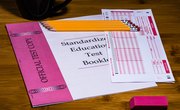Reading is an ability that many people take for granted. When you read, you decode new words and comprehend complex associations without thinking about it. But when students are learning how to read, many struggle with various deficits that can be difficult for teachers to grasp without specialized assessments.
The Woodcock Reading Mastery Test, sometimes abbreviated as WRMT, is an assessment that was designed to help teachers analyze their students’ reading skill deficits. Such tests make it easier for teachers to diagnose and remediate reading problems for individual students rather than taking a one-size-fits-all approach.
What Is the Woodcock Reading Mastery Test?
The Woodcock Reading Mastery Test is a norm-based assessment used to estimate reading comprehension and readiness. Although it is usually applied in lower elementary school grade levels, it can be used to measure the reading aptitude of anyone older than five.
There are two forms of the WRMT: one used for testing and the other for retesting. Teachers can use the scores produced by the test to estimate where the student stands compared to the grade and age percentiles. Teachers and parents can then use the subsection scores to help students become better readers.
What Are the Subtests of the WRMT?
The Woodcock Reading Mastery assessment has five types of questions: letter identification, word identification, nonsense words, word comprehension and passage comprehension.
For letter identification questions, test takers must identify uppercase and lowercase letters in different fonts.
For word identification questions, test takers read words from a list aloud. The test proctor will prompt them to move on if they take more than five seconds to identify a word.
For nonsense word questions, test takers are tasked with identifying if given words are real or not.
For word comprehension questions, test takers must recognize the meaning of synonyms, antonyms and analogies.
For passage comprehension questions, students fill in the blanks of a passage to demonstrate that they understand its meaning.
How to Administer the Woodcock Reading Mastery Test
To administer the Woodcock Reading Mastery assessment, follow the guidelines that accompany the test materials. Your materials kit should include an answer recording form, an Oral Reading Fluency Record form, a Stimulus Book, Rapid Automatic Naming (RAN) cards, a Listening Comprehension audio CD (Word Id, Word Attack pronunciation as well), a manual and software.
The manual will prompt you on the order of questions and give directions on how to administer each section. Some types of questions allow for only a limited time for the test taker to score points with the correct answer. Keep a stopwatch or timer handy to keep track of the allotted time. Record correct answers on your scoring sheets.
Most test kits come with software, so you will not have to score the test by hand. All you will have to do is input the responses into the computer, and the software will produce a score with percentile graphs. Ask your school if they already have a subscription to the web-based administration, scoring and reporting software.
Understanding WRMT Scores
There are two types of reports available for the Woodcock Reading Mastery assessment: progress reports and interpretive reports.
Progress reports will provide a graph of the test taker’s performance over multiple tests using a developmental scale score using growth scale values. This will help teacher and parents see if the test taker is making progress over time.
Interpretive reports give raw scores, age equivalencies, growth scale values and norm percentile rank for each test cluster. The growth scale values will show if the test taker is making progress compared with their own former scores. Percentile ranks and their accompanying bell curve illustration will show how the test taker compares to other students their age on each question type.
Related Articles
References
Tips
- Tip: Remember to follow basal and ceiling rules when administering the test to ensure accurate scoring.
Warnings
- Warning: Refer to the Examiner's Manual for any questions concerning scoring the assessment.
Writer Bio
Rebecca Renner is a teacher and college professor from Florida. She loves teaching about literature, and she writes about books for Book Riot, Real Simple, Electric Literature and more.











